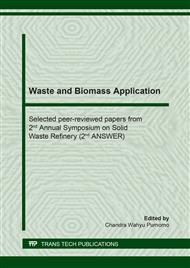[1]
M. Syamsiro, B.B. Sitompul, U.B. Surono, B. Prabowo, M.K. Biddinika, Alternative solid biofuel production from palm oil residue wastes employing dry torrefaction, 020028 (2018) 020028.
DOI: 10.1063/1.5046224
Google Scholar
[2]
M. Syamsiro, R.M.A. Nasution, U.B. Surono, N.A. Pambudi, M. Kismurtono, Dry and wet torrefaction of empty fruit bunch to produce clean solid fuel for cooking application, J. Phys. Conf. Ser. 1175 (2019) 0–10.
DOI: 10.1088/1742-6596/1175/1/012272
Google Scholar
[3]
N.A. Pambudi, S. Torii, M. Syamsiro, H. Saptoadi, I.M. Gandidi, Emission factor of single pellet cake seed Jatropha curcas in a fix bed reactor, J. Brazilian Soc. Mech. Sci. Eng. 34 (2012) 184–192.
DOI: 10.1590/s1678-58782012000200009
Google Scholar
[4]
M. Syamsiro, H. Saptoadi, B.H. Tambunan, Experimental investigation on combustion of Bio-pellets from indonesian cocoa pod husk, Asian J. Appl. Sci. 4 (2011) 712–719.
DOI: 10.3923/ajaps.2011.712.719
Google Scholar
[5]
F. Numberi, Sagu: Potensi yang Masih Terabaikan, Jakarta: Bhuana Ilmu Populer (BIP), (2011).
Google Scholar
[6]
N. A. Denitasari, A. Wulanawati and H. Purwaningsih, Briket Ampas Sagu sebagai Bahan Bakar Alternatif (Sago Waste Briquette as an ALternative Fuel), Undergraduate Theses, Bogor Agricultural University, Bogor, (2011).
Google Scholar
[7]
S. Maarif, W. Widyawidura, M. N. Aridito, H. D. Kurniasari and M. Kismurtono, Waste-to-Energy Development Using Organic Waste Recycling System (OWRS): A Study Case of Giwangan Market, International Journal of Renewable Energy Research (IJRER), vol. 9, no. 1 (2019) pp.354-362.
DOI: 10.20508/ijrer.v9i1.8822.g7622
Google Scholar
[8]
N.A. Pambudi, T. Laukkanen, M. Syamsiro, I.M. Gandidi, Simulation of Jatropha curcas shell in gasifier for synthesis gas and hydrogen production, J. Energy Inst. 90 (2017) 672–679.
DOI: 10.1016/j.joei.2016.07.010
Google Scholar
[9]
Direktorat Jenderal Perkebunan, Statistik Perkebunan Indonesia 2015 - 2017 Sagu, Sekretariat Direktorat Jenderal Perkebunan, Jakarta, (2017).
DOI: 10.5994/jei.19.1.62
Google Scholar
[10]
R. S. Singhal, J. F. Kennedy, S. M. Gopalakrishnan, A. Kaczmarek, C. J. Knil and P. F. Akmar, Industrial production, processing, and utilization of sago palm-derived products, Carbohydrate Polymer, vol. 72, no. 1 (2008) pp.1-20.
DOI: 10.1016/j.carbpol.2007.07.043
Google Scholar
[11]
M. N. Aridito, The Influence of Particle Size and Fuel Consumption Rate on Oil Characteristic from Pyrolysis of Aluminium Foil Coated Polyethilene (AI-PE) Waste, Conserve: Journal of Energy and Environmental Studies, vol. 1, no. 1 (2017) pp.20-33.
DOI: 10.30588/cjees.v1i1.250
Google Scholar
[12]
E. Suhendi, G. U. Paradise and I. Priandana, Pengaruh Laju Alir Udara dan Waktu Proses Gasifikasi terhadap Gas Producer Limbah Tangkai Daun Tembakau Menggunakan Gasifer Tipe Downdraft, Jurnal Bahan Alam Terbarukan, vol. 5, no. 2 (2016) pp.45-53.
DOI: 10.15294/jbat.v5i2.6054
Google Scholar
[13]
M. N. Aridito and M. S. Cahyono, Pengaruh Laju Pemanasan dan Laju Hisap Gas pada Proses Pirolisis Twin Retort Rocket Stove terhadap Karakteristik Bioarang dan Briket Limbah Serbuk Kayu, Prosiding SENIATI, Institut Teknologi Nasional, Malang, (2019).
DOI: 10.37412/jrl.v19i1.12
Google Scholar
[14]
W. Widyawidura, M. R. P. Liestiono, M. S. Cahyono, A. Prasetya and M. Syamsiro, Pengaruh Jenis Bahan terhadap Proses Gasifikasi Sampah Organik Menggunakan Updraft Fixed Bed Reactor, Jurnal Engine: Energi, Manufaktur, dan Material, vol. 1, no. 2 (2017) pp.30-37.
DOI: 10.30588/jeemm.v1i2.258
Google Scholar
[15]
W. Widyawidura and J. I. Pongoh, Potensi Waste to Energi Sampah Perkotaan untuk Kapasitas 1 MW di Propinsi DIY, Jurnal Mekanika dan Sistem Termal (JMST), vol. 1, no.1(2016) pp.21-25.
Google Scholar



